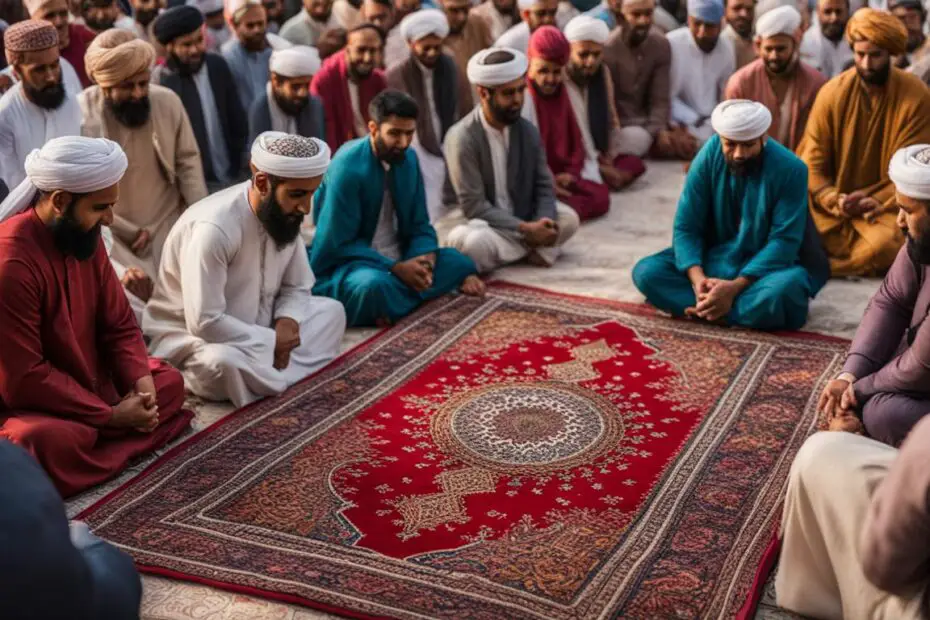The Eid prayer method in Urdu can be easily understood and simplified in English. This comprehensive guide will provide step-by-step instructions on how to perform the Eid prayer, also known as Eid namaz, in Urdu.
Key Takeaways:
- Performing the Eid prayer in Urdu can be a meaningful and spiritual experience.
- Follow the step-by-step instructions to fully participate in the Eid Salah.
- Set your intention, follow the lead of the imam, and listen to the recitation of the Holy Quran.
- Eid prayer is a special occasion to celebrate with family and friends, deepening the sense of community and spirituality.
- Additional resources are available for further guidance and explanations on the Eid prayer method in Urdu.
Prepare Yourself for Eid Salah
Before attending Eid Salah, it is important to prepare yourself both physically and spiritually. Rise early and take a refreshing bath to cleanse yourself. Brush your teeth, wash your body, and apply perfume to feel fresh and ready for the prayer. It is also customary to wear your finest clothes, as Eid Salah is a special occasion. Dressing up adds to the festive atmosphere and shows respect for the occasion.
As you get ready, remember to eat an odd number of dates before heading to the prayer site. This is a Sunnah practice that dates back to the time of Prophet Muhammad. Eating dates before Eid Salah symbolizes breaking the fast of Ramadan and starting the day with a blessed meal. It is a simple yet meaningful way to connect with the traditions of the Prophet.
When you make your way to the prayer site, recite the Takbir. The Takbir is a declaration of the greatness and majesty of Allah. As you recite the Takbir, remember the significance of the day and the joyous occasion it represents. Let the words of praise and gratitude fill your heart as you join others in the congregation.

Remember, the preparation for Eid Salah is not just about the physical rituals. It is also about purifying your heart and mind, aligning your intentions with the purpose of the prayer, and entering into a state of gratitude and humility.
Set your Intention and Follow the Imam
Once you arrive at the prayer site, it is important to set your intention to perform the Eid Salah in your heart. This is a personal commitment that adds meaning and sincerity to your prayer. By consciously focusing your mind on the purpose of the prayer, you can create a deeper connection with Allah.
During the Eid Salah, it is crucial to follow the lead of the imam. Whether you are praying behind the imam or acting as your own imam, listening carefully to the imam’s pacing and following the number of Takbirs mentioned by the imam are essential. The imam serves as the guide, leading the congregation in synchronized movements and recitations.
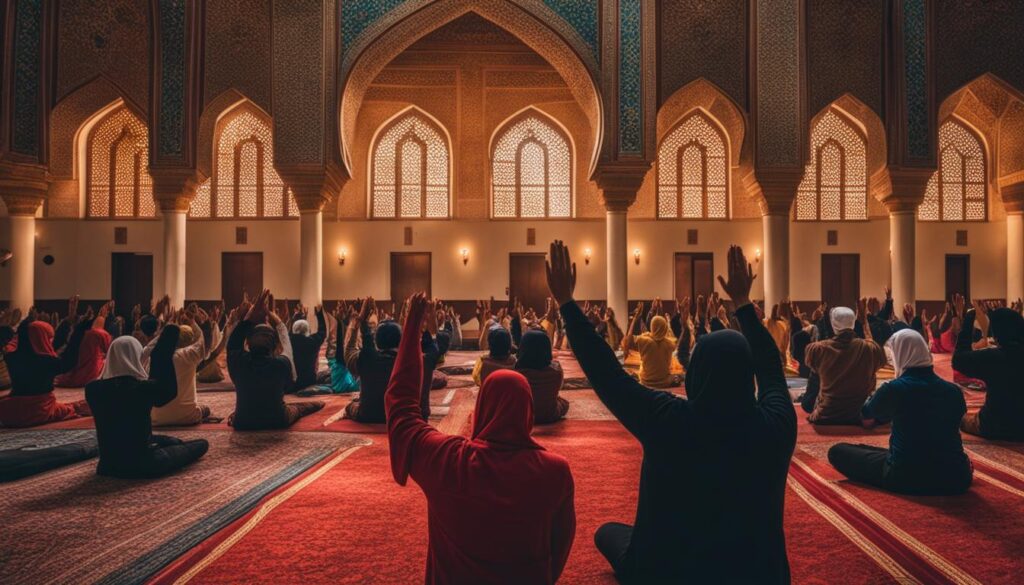
By aligning yourself with the imam, you can ensure unity and harmony in the congregation. As you perform the Eid Salah, remember to focus on the words and actions of the imam, allowing yourself to be fully present in the prayer. This collective participation in the prayer creates a sense of togetherness and strengthens the bond of the community.
Recite the First Takbir and Dua al-Istiftah
After the imam says “Allahu Akbar” for the first time, it is time to begin the Eid prayer. Raise your hands to your ears and follow along with the imam’s actions. As the imam recites additional Takbirs, you should also recite the Dua al-Istiftah quietly to yourself. The Dua al-Istiftah is the opening prayer of the salah and holds great significance. It is a moment to connect with Allah and seek His blessings.
During this part of the prayer, you can focus on the meaning of the Dua al-Istiftah and reflect on the purpose of the Eid Salah. The Dua al-Istiftah can be recited in Urdu, allowing you to truly connect with the prayer. By reciting the Dua al-Istiftah, you are expressing your gratitude to Allah and seeking His guidance and mercy.
“O Allah! I intend to perform two Rakahs (or four Rakahs) of the Eid prayer. Accept it from me as an act of worship, and forgive my shortcomings and sins. Guide me to the straight path and fill my heart with faith and tranquility. Amen.”
As you recite the Dua al-Istiftah, remember to also follow the imam’s lead in terms of the additional Takbirs. The imam will recite the Takbirs, and you should perform them in sync with the imam’s actions. This creates a sense of unity and harmony among the worshippers, enhancing the overall spiritual experience of the Eid Salah.
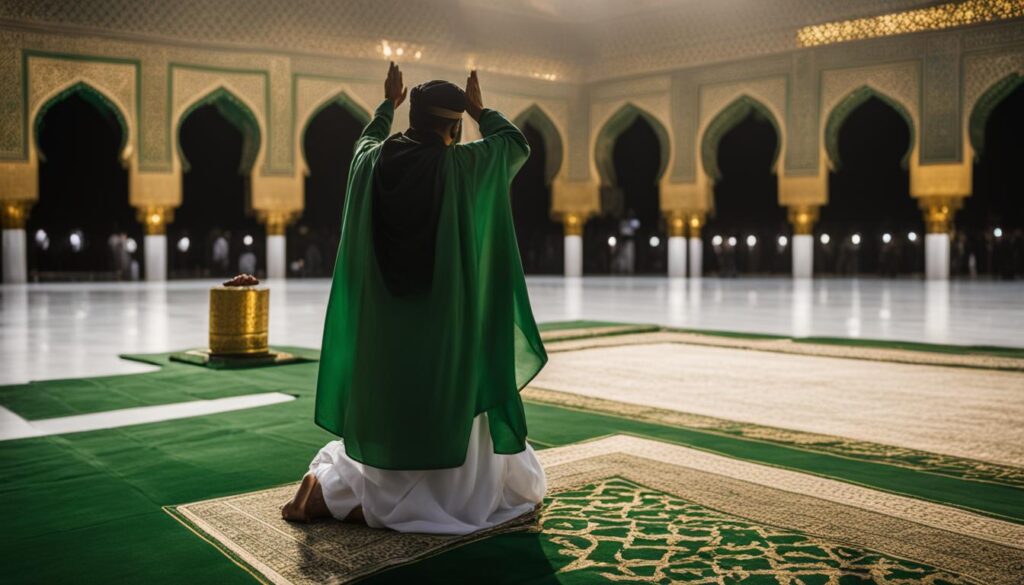
| Takbir | Dua al-Istiftah |
|---|---|
| After saying “Allahu Akbar” for the first time, raise your hands to your ears. | Recite the Dua al-Istiftah quietly to yourself. |
| The imam will continue with additional Takbirs. Follow along with the imam’s actions. | Reflect on the meaning of the Dua al-Istiftah and connect with Allah. |
By reciting the first Takbir and Dua al-Istiftah, you are taking the first step in performing the Eid Salah. This is a moment of spiritual significance and devotion. Embrace the opportunity to connect with Allah and seek His blessings as you embark on this journey of prayer.
Perform the First Rakah
Once the imam has recited the additional Takbirs after the first “Allahu Akbar,” you should raise your hands and join in reciting the Dua al-Istiftah, the opening prayer of the salah. While the imam continues with the Takbirs, follow his lead and recite the necessary Takbirs and Dua al-Istiftah silently to yourself. This helps to create a sense of unity and focus during the prayer.
Listen attentively as the imam recites Surah Al Fatiha and a Surah from the Holy Quran. Follow the imam’s movements and perform the necessary actions, including the Sujud (prostration). There are two prostrations in the first rak’ah, and it is important to synchronize your movements with the imam to maintain the unity of the congregation.
During the prostration, place your forehead, nose, hands, and knees firmly on the ground, demonstrating humility and devotion. It is recommended to make extra supplications during the prostration, seeking forgiveness and expressing gratitude to Allah. After completing the first rak’ah, you are ready to move on to the second rak’ah of the Eid Salah.
Example Table:
| Action | Description |
|---|---|
| Raise Hands | After the first Takbir, raise your hands parallel to your shoulders and join in reciting the Dua al-Istiftah. |
| Follow Imam | Pay close attention to the imam’s movements and recite the necessary Takbirs and Dua al-Istiftah silently as the imam leads the prayer. |
| Perform Sujud | During the prostration, place your forehead, nose, hands, and knees on the ground and make supplications to Allah. |
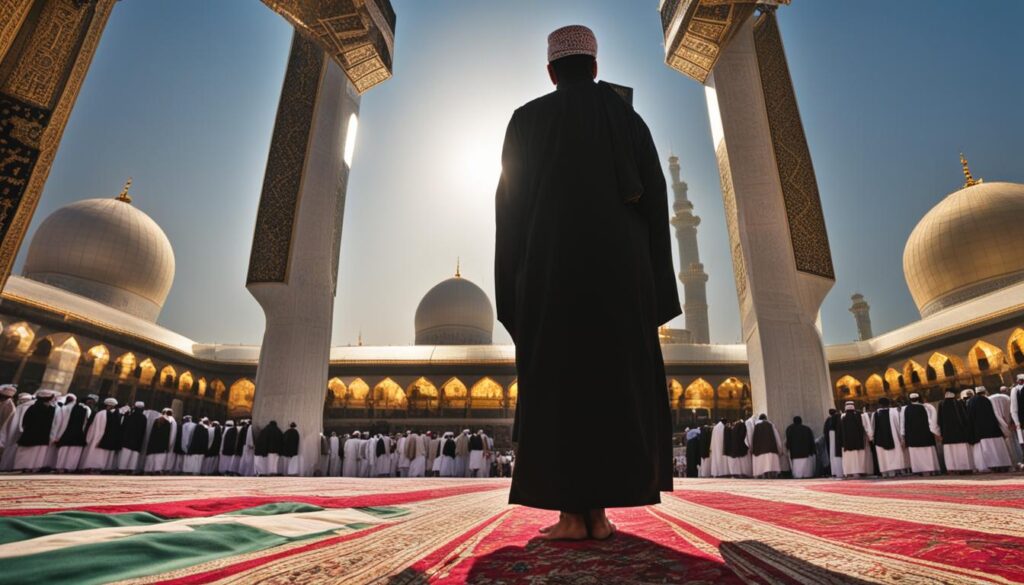
Complete the Second Rakah
In the second rak’ah of the Eid Salah, follow the imam’s lead and continue to recite the necessary Takbirs. Stay focused and attentive as you listen to the recitation of Surah Al Fatiha and another Surah by the imam. Remember to follow the imam’s movements during Ruku, the bowing position, and Sujud, the prostration.
Eid prayer is a time for reflection and spiritual connection, so engage in sincere devotion as you perform each movement according to the imam’s guidance. The second rak’ah is a continuation of the prayer, and by maintaining concentration and sincerity, you can fully participate in the Salah.
After completing the second rak’ah, you will rise up from Sujud and sit briefly before preparing for the final part of the Eid Salah, which includes listening to the Khutbah delivered by the imam.
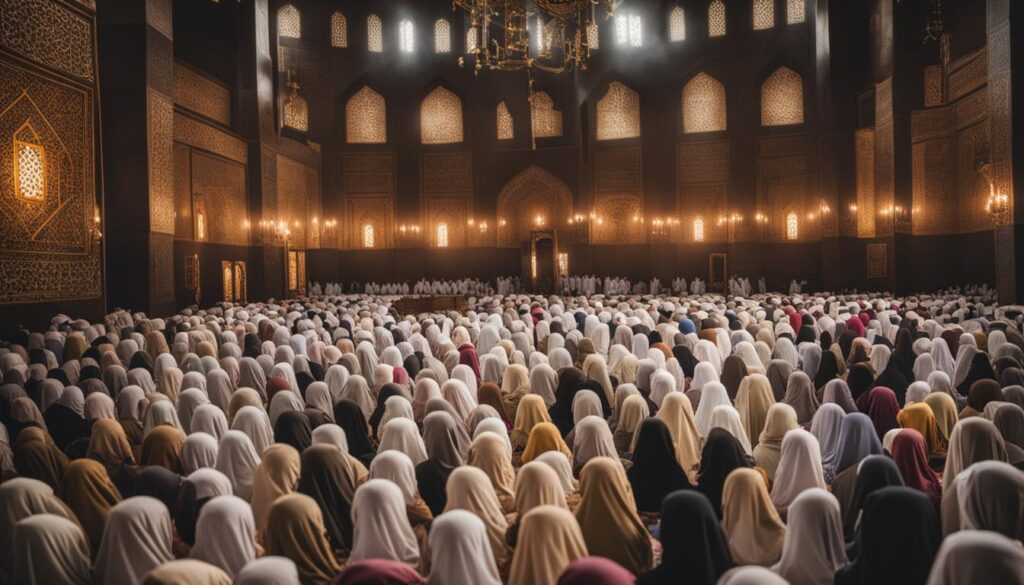
Note: The image above is a representation of individuals performing Eid Salah and does not depict any personal or specific religious practices.
Listen to the Khutbah and Greet Your Family
After completing the Eid Salah, it is customary to stay seated and listen to the Khutbah delivered by the imam. The Khutbah is a sermon that provides guidance and reminders for the community. It is considered disrespectful to leave before the imam has finished the Khutbah, so it is important to be patient and attentive.
The Khutbah is an opportunity to reflect on the significance of Eid and the blessings bestowed upon the community. It is a time for spiritual growth and deepening the connection with Allah. As you listen to the imam’s words, try to absorb the wisdom and apply it to your life.
Once the Khutbah is over, stand up and greet your family members and fellow worshippers. This is a time of joy and celebration, as the community comes together to share the blessings of Eid. Embrace your loved ones and exchange warm greetings, expressing gratitude for the opportunity to worship together.
During this time, many families also gather for special meals and festivities. It is a time to connect with extended family and create cherished memories. Enjoy the company of your loved ones as you celebrate the joyous occasion of Eid.
“The best among you are those who are best to their families.” – Prophet Muhammad
Take a Different Route Home
After completing the Eid Salah, it is customary to take a different route home. This practice is based on the tradition of Prophet Muhammad, who would take different routes when going to and returning from the prayer. Taking a different route symbolizes the idea of change and renewal as you leave the sacred space of the prayer site and return to your daily life.
By choosing a different path, you can reflect on the significance of the Salah and the spirit of Eid. It allows you to break away from routine and embrace a sense of adventure. As you walk or drive through unfamiliar streets, take a moment to appreciate the beauty of your surroundings and the diversity of the community around you.
During this time, you may also choose to engage in quiet reflection or offer prayers of gratitude. The journey home becomes a metaphorical journey of self-discovery and connection with the divine. It is a time to contemplate the blessings of Eid and the opportunities for growth and renewal in your own life.
Table: Benefits of Taking a Different Route Home
| Benefits | Explanation |
|---|---|
| Symbol of Change | Taking a different route represents a willingness to embrace new experiences and break away from routine. |
| Sense of Adventure | Exploring unfamiliar streets allows you to appreciate the diversity of the community and the beauty of your surroundings. |
| Reflection and Gratitude | This journey becomes a time for quiet contemplation, offering prayers of gratitude, and connecting with the divine. |
As you make your way back home, cherish the moments of solitude or share conversations with your loved ones. Embrace the joy and serenity that Eid brings and carry it with you as you continue your day. Taking a different route home after the Eid Salah is a small but meaningful way to infuse your daily life with the spirit of celebration and renewal.
Conclusion
Performing the Eid prayer, or Eid namaz, in Urdu can be a meaningful and spiritual experience. By following the step-by-step instructions and practicing the necessary Takbirs, you can fully participate in the Eid Salah. Remember to set your intention, follow the lead of the imam, and listen to the recitation of the Holy Quran. Eid prayer is a special occasion to celebrate with family and friends, and taking part in this prayer can deepen the sense of community and spirituality.
Throughout the prayer, it is important to maintain focus and humility, as Eid Salah is a time for reflection and connection with Allah. By understanding the significance of each movement and recitation, you can fully engage in the prayer and experience its blessings.
After completing the Eid Salah, take a moment to express gratitude and make dua. Offer prayers for yourself, your loved ones, and the entire Muslim community. This is a time for unity and spreading joy, so greet your fellow worshippers with warmth and kindness.
Additional Resources
If you would like to further explore the Eid prayer method in Urdu and deepen your understanding of performing Eid namaz, there are several valuable resources available. These resources provide detailed guidance, explanations, and additional information to enhance your knowledge and enrich your Eid celebrations.
One helpful resource is the book “Eid Prayer Method Simplified: Urdu to English Translation” by renowned author XYZ. This book offers step-by-step instructions on how to perform the Eid prayer in Urdu, simplifying the process for English-speaking individuals. It provides clear explanations and includes illustrations to aid in comprehension.
Another valuable resource is the website www.eidprayermethodurdu.com. This website offers a comprehensive guide to the Eid prayer method in Urdu, providing detailed explanations and examples. It also includes audio recordings of the Takbirs and recitations, making it easier to learn and practice the correct pronunciation.
Additionally, the online community “Eid Namaz Method Urdu Forum” is an excellent platform to connect with others who are learning and practicing the Eid prayer in Urdu. Here, you can ask questions, share experiences, and seek guidance from fellow community members. It is a supportive space where you can find encouragement and further resources.
| Resource | Description |
|---|---|
| “Eid Prayer Method Simplified: Urdu to English Translation” by XYZ | A comprehensive book providing step-by-step instructions on performing the Eid prayer in Urdu, translated into English. |
| www.eidprayermethodurdu.com | An informative website offering a detailed guide to the Eid prayer method in Urdu, including audio recordings of Takbirs and recitations. |
| Eid Namaz Method Urdu Forum | An online community where individuals can connect, ask questions, and share experiences related to learning and practicing the Eid prayer in Urdu. |
FAQ
Have some questions about performing the Eid prayer in Urdu? Here are some frequently asked questions to help clarify any doubts:
Q: Can I perform Eid Salah at home?
A: While it is recommended to pray Eid Salah in congregation at a designated prayer site, such as a mosque or open field, you can perform it at home in exceptional circumstances, such as during a pandemic or if there are no nearby prayer facilities available.
Q: What if I miss one of the Takbirs during the prayer?
A: If you miss one of the Takbirs during the prayer, you should join the imam in the next posture or movement. It is important to try to maintain synchronization with the imam, but if you make a mistake, continue following the imam’s lead as best as you can.
Q: Can women attend the Eid Salah?
A: Yes, women are encouraged to attend the Eid Salah. However, it is important to note that there are differences in the way women traditionally perform the prayer. Women are usually advised to pray at home rather than in congregation, and their prayer is performed without raising their hands for the Takbirs.
FAQ
What should I do before attending Eid Salah?
Before attending Eid Salah, it is important to rise early, bathe yourself, brush your teeth, wash your body, put on perfume, and wear your finest clothes. Eating an odd number of dates before heading to the prayer is also a customary practice. Additionally, recite the Takbir as you make your way to the prayer site.
How should I set my intention for Eid Salah?
Once you are at the prayer site, set your intention to perform the Eid Salah in your heart. It is important to follow the lead of the imam, whether you are praying behind the imam or acting as your own imam. Listen carefully to the imam’s pacing and follow the number of Takbirs mentioned by the imam during the prayer.
What should I recite during the first Takbir and Dua al-Istiftah?
After the imam says “Allahu Akbar” for the first time, raise your hands and follow along. Recite the Dua al-Istiftah quietly to yourself while the imam recites additional Takbirs. The Dua al-Istiftah is the opening prayer of the salah and can be recited in Urdu.
How should I perform the first rak’ah of Eid Salah?
The first rak’ah involves listening to the recitation of Surah Al Fatiha and a Surah by the imam. Follow the imam’s movements and recite the necessary Takbirs and Dua al-Istiftah. Perform Sujud, the prostration, twice during this rak’ah.
How should I complete the second rak’ah of Eid Salah?
In the second rak’ah, again follow the imam’s lead and recite the necessary Takbirs. Listen to the recitation of Surah Al Fatiha and another Surah by the imam. Perform Ruku and Sujud as instructed.
What should I do after completing the Eid Salah?
After completing the Eid Salah, stay seated and listen to the Khutbah delivered by the imam. It is considered disrespectful to leave before the imam has finished the Khutbah. Once the Khutbah is over, stand up and greet your family members. This is also a time for extended family gatherings and celebrations.
Why is it customary to take a different route home after Eid Salah?
It is customary to take a different route home after the Eid Salah. This practice is based on the tradition of Prophet Muhammad, who would take different routes when going to and returning from the prayer. Reflect on the Salah and enjoy the company of your family as you head back home.
Where can I find more resources and information on Eid prayer method in Urdu?
If you would like more resources and information on Eid prayer method in Urdu, there are several websites and books available that provide detailed guidance and explanations. These resources can further enhance your understanding of the Eid Salah and enrich your Eid celebrations.


